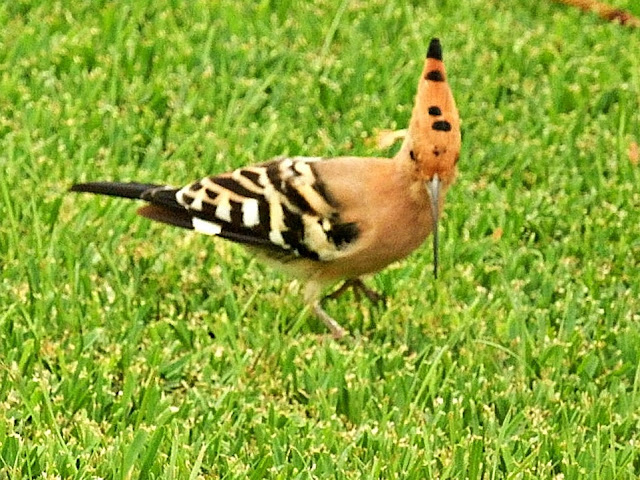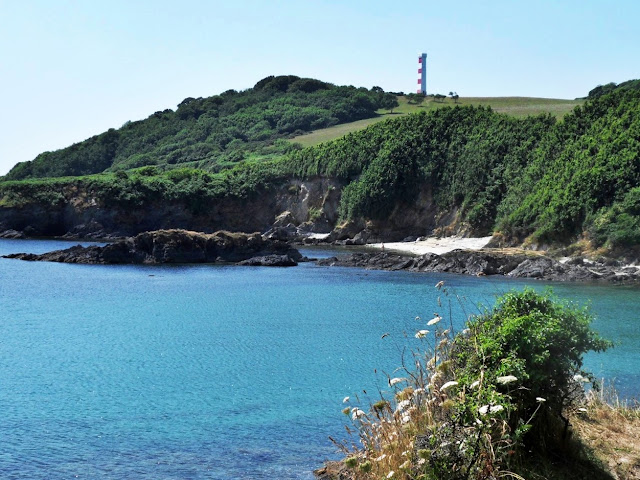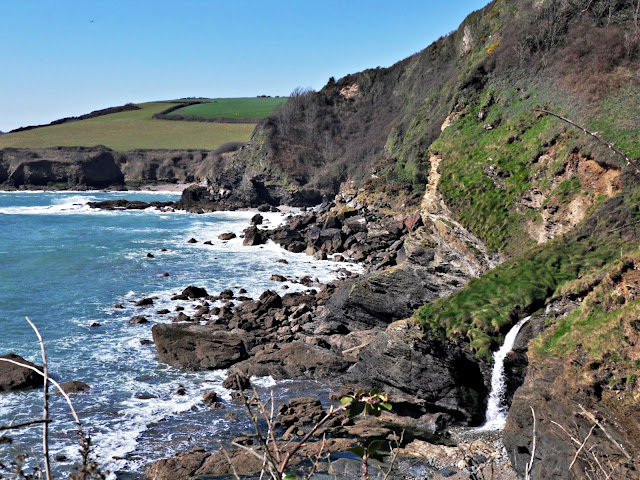Friday, 20 September 2019
From Cornwall To The Canary Islands
Apologies that there haven't been any Cornwall posts for a short while. I have been away in Lanzarote, Canary Islands.
I have taken the liberty of a publishing a couple of random photos from the island.
The photo above is leaving Exeter, England by plane and below is a view of Lanzarote's volcanic countryside - perhaps not everyone's cup of tea!
I quite like the scenery though, certainly very different from Cornwall.
But there are also some pleasant beaches and ...
… also some very busy beaches - the sort that has no appeal to me, but each to their own taste. I like a bit of elbow room on the beach.
And to finish with a couple of Lanzarote birds.
The one below I believe is a Hoopoe, though I called it an upside down bird.
… because from some angles the bird looks to be upside down!
Anyway, apologies for the lack of Cornwall photos, hopefully normal service will be resumed.
Tuesday, 10 September 2019
Polridmouth, Menabilly, Cornwall - Daphne du Maurier Country, Cornwall
The author Daphne Du Maurier made her home for many years at a large house on the Cornish Menabilly estate - this was the ancestral seat of the Rashleigh family.
The first line of her book, Rebecca, reads "Last night I dreamt I went to Manderley again. It seemed to me I stood by the iron gate leading to the drive …" Manderley is Menabilly.
Her book The King’s General was inspired by the history of Menabilly during the 1600s.
Unfortunately the house cannot be seen by the public, as it is well hidden.
The only photo I have of the Menabilly House is the black and white photo above, showing Daphne Du Maurier and her children.
What can be seen, though, is the cottage and boathouse as shown at the top of this post. This is where Rebecca would entertain her guests and where she was supposedly murdered.
So many of Du Maurier's books are based in this part of Cornwall - it is often referred to as 'DuMaurier country'
The lake, as below, was made in the thirties by damming a small stream. This part of the estate can be clearly seen by walkers or people visiting the small beaches.
During World War Two lights were fixed around the lake to confuse any enemy aircraft. Nearby Fowey was a port used for the build up to the D-Day landings. Over 2,000 American troops were based in the area.
Going back to the cottage, this is by the sea and there are small beaches nearby, notably Polridmouth (pronounced Pridmouth). There aren't normally too many people about.
Along the coast Gribbin Head can be seen and the red and white striped beacon.
In her book,Rebecca, Du Maurier writes:
And I thought of the tide, how swift it ran and strong into the little cove. The wind blew down from the headland like a funnel. I got the boat out into the bay. I got her out there beyond the beacon …"
And below a clearer photo of the daymark Gribbin tower.
I have written before that I love this stretch of coastline.
As for Daphne du Maurier (1907-1989) she moved away from Menabilly in 1965 following her husband's death. She remained in Cornwall, near Par, in a house called Kilmarth - which she used as a setting for her book The House on the Strand.
See more photos of Menabilly:
The Wonderful Coastline At Menabilly - Daphne du Maurier Country
Saturday, 7 September 2019
Who or What are Cornish Knockers?
A further tale from The drolls, traditions, and superstitions of old Cornwall by Robert Hunt (1807 -1887). This tries to explain who are the Knockers, often mentioned in stories of Cornish tin mines. It appears that Charles Kingsley (1819-1875) posed the question: 'Who are the Knockers?' This was the reply:
One Saturday night I had retired to rest, having first seen that all members of the household had gone to their bedrooms. These were my daughters, two female servants and an old woman named Mary, who was left by the proprietor in charge of the house which I occupied.
I had some time in bed when I distinctly heard a bedroom door open and footsteps which, after moving about for some time in the passage or landing, from which the bedrooms opened, slowly and carefully descended the stairs.
I heard a movement in the kitchen below, and the footsteps again ascended the stairs and went into one of the bedrooms. The noise continued so long, and was so regularly repeated that I began to fear lest one of the children were taken suddenly ill. Yet I felt assured, if it was so, one of the servants would call me. Therefore I lay still and listened until I fell asleep.
On the Sunday morning, when I descended to the breakfast-room, I asked the eldest of the two servants what had occasioned so much going up and down stairs in the night. She declared that no one had left their bedrooms after they had retired to them.
I then enquired of the younger girl, and each of my daughters as they made their appearances. No one had left their rooms - they had not heard any noises.
My youngest daughter, who had been after this enquiry of mine for some minutes alone with the youngest servant, came laughing to me.
"Papa, Nancy says the house is haunted and that they often heard strange noises in it."
So I called Nancy; but all I could learn from her was that noises, like men going up and down stairs, of threshing corn and 'beating the borer' (a mining operation) were not uncommon.
We all laughed over papa's ghost during breakfast, and by and by old Mary made her appearance.
"Yes," she said, "it is quite true, as Nancy 'as told you. I have often heard all sorts of strange noises; but I b'lieve they all come from the lode of tin which runs under the house. Wherever there is a lode of tin, you are sure to hear strange noises."
"What, Mary! was it the knockers I heard last night?"
"Yes, 'twas the knockers, down working upon the tin, no doubt of it."
This was followed by a long explanation, and numerous stories of mines in Leland and St. Ives district, in which the knockers had often been heard.
After a little time, Mary, imagining I suppose that the young ladies might not sleep in a house beneath which the knockers were at work, again came with her usual low curtsey into the parlour.
"Beg pardon, sir," says she, "but none of the young ladies need be afraid. There are no spirits in the house; it is very nearly a new one, and no one has ever died in the house."
I have previously touched on the subject of the Knockers on my blog post Knockers, Tin Mines and Cornish Pasties.
Wednesday, 4 September 2019
Cornwall's Coastal Path With Wonderful Year Round Sea Views
"Okay," said this chap I met on a walk, "but Cornwall must be a cold, drab place once the summer sun has gone."
Well no! I'll answer the assumption with today's photos taken on a cold day, out of the holiday season - look at the views! The trees and scrub may be brown but the grass and sea are alive with colour. The light can be so good in Cornwall, it's why artists head this way.
The photos are from a walk starting at the small hamlet of Trenarren on Cornwall's south coast and simply walking along the coastal path, passing Black Head and looking out to sea.
One of the great things about Cornwall is this coastal path stretching around all of the county and beyond. There are no restrictions (unless it is dangerous) it's all a public right of way.
Sure, some of the path can be rough and uneven but at other times there may be wonky steps to make climbing the cliffs easier.
There are ups and downs, of course - such is life - but that makes it all the more interesting.
Looking inland on this particular stretch of path there are farmer's fields, mostly fenced off but at times there are public rights of way across these fields.
Even the cattle appreciate how lucky we are living in Cornwall.
On a cold, clear day what can be better than walking along the coast and breathing in all of that fresh air. Perfect!
P.S. To quote the Geography of Climate:
"Cornwall has a temperate Oceanic climate, with mild winters and cool summers. Cornwall has the mildest and sunniest climate in the United Kingdom, as a result of its oceanic setting and the influence of the Gulf Stream. Winters are amongst the warmest in the country, due to the moderating effects of the warm ocean currents, and frost and snow are very rare at the coast and are also rare in the central upland areas. Cornwall is one of the sunniest areas in the UK, with over 1541 hours of sunshine per year, with the highest average of 7.6 hours of sunshine per day in July."
See also:
South West Coast Path Walking From Trenarren, Cornwall
Monday, 2 September 2019
Mevagissey, Cornwall at Night
I know I have done a couple of posts on Mevagissey recently but decided to include these photos as they were taken early evening and much later.
The sky in the photo above still has a pink tinge and there were several other people enjoying the cool of the evening after a rainy day.
A few people were fishing near Mevagissey's small lighthouse.
All was still within the harbour itself, boats were tucked up safely for the night.
The restaurants along the front of the harbour were busy, especially the popular Sharksfin - the large white building -which is open from 10am to 11pm.
Gradually, as per normal, the night got darker.
By the time we had done what we wanted to do the sky was very dark and a fine rain filled the air - so we made our way back to our car.
Saturday, 31 August 2019
10 Photos of August Flowers and Colour In Our Garden In Cornwall
Some colour and flowers I have snapped in our garden this month. We had some wonderful hot, sunny weather but it has now turned to rain and quite windy at times - thus several photos with raindrops!
Always like dahlia and lilies because they are mostly trouble free and pop up year after year.
The flowers in the vase on our kitchen windowsill were all blown over by the wind and rain. I think I need to give the flowers better supports!
Hydrangeas are a little damp and some of the heads are now fading.
A damp gladioli which survived the wind ...
… and fuchsia don't seem to mind raindrops.
A gladioli on a sunny day ...
… but then it rained again!
Finally geraniums.
Also see:
14 Photos of July Flowers and Colour In Our Garden In Cornwall
Thursday, 29 August 2019
The Decapitated Saint Chose Where He Wanted His Cornish Church To Be Built
My previous post was about the lovely church at Lanteglos-by-Fowey. The patron saint is St.Willow - sometimes shown as St.Wyllow or even St.Wylloc.
Little seems to be known of the saint, but what is known is quite unusual, to say the least.
Like so many of the saints who passed through Cornwall he was born in Ireland. It is said that his journey was 'piloted by helpful fish' up to Pont Pill in Cornwall where he established his hermitage.
Pont Pill, photo at the top of the post, is along Cornwall's Fowey river and only a short walk from Lanteglos-by-Fowey church. It's a lovely spot.
The 'helping fish' was a little unusual, but so is the next part of St.Willow's story. Somehow he got into an argument and was slain by a man called Melyn. The name is sometimes shown as Melyn ys Kyrede which translates to Kindred of someone called Melyn. But, whatever, the saint was beheaded.
This isn't the end of the story though. St.Willow simply picked up his head and proceeded to the place where he wanted a church to be built in his honour.
His wish came true for on that spot is now the church at Lanteglos-by-Fowey.
I believe that a saint carrying his own head is known as a cephalophore in Christian art.
St.Willow has a feast day on the 7th of July.
Subscribe to:
Posts (Atom)
FEATURED POST
Cornwall's Lizard Peninsula
I know my wife and I and live in Cornwall but we had a break away from home on Cornwall's L izard Peninsula - one of our favourit...














































